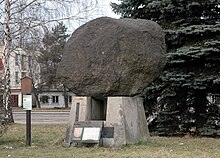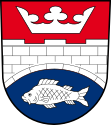Kunčice nad Ostravicí
| Kunčice | ||||
|---|---|---|---|---|
|
||||
| Basic data | ||||
| State : |
|
|||
| Region : | Moravskoslezský kraj | |||
| District : | Ostrava-město | |||
| Municipality : | Ostrava | |||
| Area : | 788 ha | |||
| Geographic location : | 49 ° 47 ' N , 18 ° 18' E | |||
| Residents : | 1,072 (2011) | |||
| Postal code : | 719 00 | |||
| License plate : | T | |||
| traffic | ||||
| Next international airport : | Ostrava Airport | |||
Kunčice (until 1908 Velké Kunčice , German Gross Kunzendorf , Polish Kończyce Wielkie ) is a district in the Slezská Ostrava district of the city of Ostrava in the Czech Republic , on the right, eastern bank of the Ostravice .

history
The place in the Duchy of Teschen , founded in 1290, was first mentioned in a document around 1305 in the Liber fundationis episcopatus Vratislaviensis (Tithe Register of the Diocese of Wroclaw ) among around seventy new villages as "Item in Cunczindorf" . The number of hooves was not yet specified in the tithing register. The originally German name Kunzendorf (from the personal name Kunze ) was mentioned at least from the early 16th century under the patronymic name with the West Slavic suffix -ice and after the founding of Neu and Klein Kunzendorf ( Kunčičky ) in the late 14th century also added to the adjective Gross / Velké , e.g. B. Welky Kunczice in 1508 (compare Kończyce Wielkie and Kunčice pod Ondřejníkem ).
The first Duke of Teschen, Mieszko I, confirmed the border on the Ostravitza with the Olomouc Bishop Theoderich von Neuhaus on August 2, 1297 . Two documents were issued on both sides, in which the area on the right bank was called Poland in Latin ( super metis et terminie apud Ostraviam in minibus buno rum ducatus nostri et episcopatus Olomucensis pro eo, quod fluvius idem qui de beret metas Polonie et Moravie distingire) . The border lost its importance in 1327 when the Duchy of Teschen came under the sovereignty of the Crown of Bohemia , but the ecclesiastical border between the Diocese of Breslau and the Diocese of Olomouc existed on the Ostravice until 1978.
In 1447 two parishes named Cunczendorff were listed in the Teschen deanery, but there were four localities in the duchy with this name, nonetheless it was most likely the first mention of the parish in Gross Kunzendorf an der Ostrawitza, which soon after lost its independence and became Branch from Moravian- speaking Vratimov and from 1654–1784 from Polish Ostrava . At first the village was directly owned by the Teschen dukes, from 1508 Welky Kunczice belonged to Jan Sedlnicky von Heraltice, later to various owners, including Ewa Czelo von Czechowice , who in the early 17th century built a Renaissance castle on the site of an older fortification -Style built.
In the description of Teschener Schlesiens by Reginald Kneifl in 1804, Kuntschitz (Groß) was German: Groß-Kunzendorf near Rattimow a village owned by Count Eduard von Wimpfen in the Teschner district . The village had 76 houses with 483 inhabitants in Silesian-Polish dialect , which was unusual for the Moravian-speaking area and was later consistently described as a Moravian-speaking municipality in the 19th century, e.g. B. on the ethnographic map of the Austrian monarchy by Karl von Czoernig-Czernhausen from 1855.
After the abolition of patrimonial it became a municipality in Austrian Silesia , judicial district Friedek, until 1901 in the district of Teschen , then in the district of Friedek . At this time industrialization followed in the area, but not in Gross Kunzendorf itself. The number of inhabitants rose to 1127 by 1869, then to 1286 by 1880 (1242 with registration) and in 1910 to 2460 (2417). The village remained predominantly inhabited by Czech-speaking (between 96.9% in 1890 and 90.6% in 1900) Roman Catholics (over 95% in 1900 and 1910) who called themselves Lachen , but there were also 210 (8.7 %) Polish- in 1900 and most of 40 (3.2%) German-speaking residents in 1880, a few dozen Protestants and Jews.
After the collapse of Austria-Hungary in late 1918, Kunčice became part of Czechoslovakia . In 1919 the incorporation into Mährisch Ostrau was considered in order to create "Groß Ostrau", but was not incorporated into Ostrau until July 1, 1941 during the German occupation . In early 1942, the Reichswerke Hermann Göring began construction of the "south building" , which was under the control of the hut in Vítkovice . After the war, the democratic administration decided in 1947–1948 to found today's large Nová huť (New Hut), which was later expanded by communists and shaped the character of the district.
Web links
Individual evidence
- ^ Idzi Panic: Śląsk Cieszyński w średniowieczu (do 1528) . Starostwo Powiatowe w Cieszynie, Cieszyn 2010, ISBN 978-83-926929-3-5 , p. 297-299 (Polish).
- ^ Wilhelm Schulte: Codex Diplomaticus Silesiae T.14 Liber Fundationis Episcopatus Vratislaviensis . Breslau 1889, ISBN 978-83-926929-3-5 , p. 110-112 ( online ).
- ↑ Liber fundationis episcopatus Vratislaviensis ( la ) Retrieved August 24, 2014.
- ↑ Robert Mrózek: nazwy miejscowe dawnego Śląska Cieszyńskiego . Uniwersytet Śląski w Katowicach , 1984, ISSN 0208-6336 , p. 94-95 (Polish).
- ^ I. Panic, 2010, pp. 272, 400
- ^ Idzi Panic: Jak my ongiś godali. Język mieszkańców Górnego Śląska od średniowiecze do połowy XIX wieku [The language of the inhabitants of Upper Silesia in the Middle Ages and in modern times] . Avalon, Cieszyn-Kraków 2015, ISBN 978-83-7730-168-5 , p. 45 (Polish).
- ^ Reginald Kneifl: Topography of the Kaiser. royal Antheils von Schlesien , 2nd part, 1st volume: Condition and constitution, in particular of the Duchy of Teschen, Principality of Bielitz and the free minor class lords Friedeck, Freystadt, German people, Roy, Reichenwaldau and Oderberg . Joseph Georg Traßler, Brünn 1804, pp. 241–242 ( e-copy )
- ↑ Ethnographic map of the Austrian monarchy by Carl Freiherr von Czoernig (1855)
- ↑ Kazimierz Piątkowski: Stosunki narodowościowe w Księstwie Cieszyńskiem . Macierz Szkolna Księstwa Cieszyńskiego, Cieszyn 1918, p. 286 (Polish, online ).


